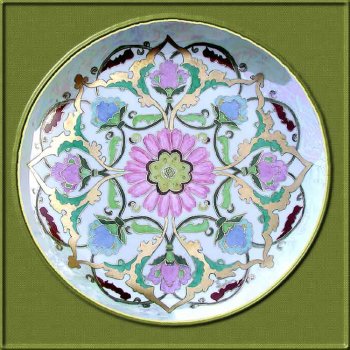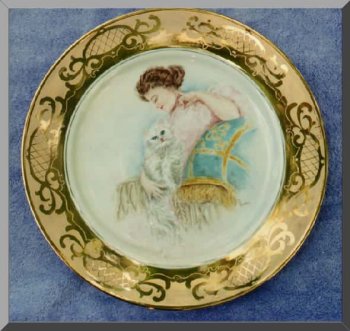| This was at a time when a few brave souls were trying to introduce the
"traditional" method of painting back and it was not being received with
enthusiasm. It wasn't popular and perhaps because it is much more difficult
to work with closed mediums and open mediums were not being used. Even with
the difficulty it presented I cannot imagine that it could be more difficult,
exacting and tedious than doing conventional work. Every line needs to be
perfect or it will sure look "home madey" as a friend sometimes described
home sewing. One needs a sharp eye and a very steady hand. There isn't the
freedom of movement or color usually found in Traditional work. (note
from Marci: traditional painting refers to the loose, impressionistic paintings
that we today identify with china painting...Conventional work was exacting
work that had stylized designs usually outlined with penwork and they were
often geometric or had repeating motifs around the plate rim . RubyGayle's
Luster plate is a good example of conventional work )
Then I discovered one of D. M. Campana's little paper backs "The Teacher of
China Painting". It is still in print but not at .25 . I think one sold
on E-bay for about $30.00, a little steep when it can still be bought.
Considering the price of most of the books today, for real information
she got a good buy even at that price!! Talk about answers, they are there.
I think it was while I was living in Woodward that I was finally introduced
to the fact that there were still many sources of supplies, even if not
close. $5.00 was about all I could afford at a time so it would take days
before I could whittle my list of wants down to fit my budget. If there
were ever any shows seminars, etc., I never heard of them. I learned to
Pad too, but not with silks. but with the pad of my finger! The revival
of interest in CP began to take place in CA in the 40's after it had reached
an all time low during and after WWI . Interest spread rather rapidly
on across the country.
I was thinking as I was scanning the ads in the old magazine today, what a wealth of beautiful and perfect quality china we could get compared to the coarse and blemished products we find today. (Not that "old is better cause we are old" ! !)
I bought some of Rosenthal's Motif recently and the raised pattern on one piece is almost nonexistent. Once upon a time 2nd's would never be sold and sometimes it is hard to tell them apart now.
My painting with Mrs. W. ended after 10 months. I had finished about
36 pieces, among which were 12 desert plates with conventional designs
and a breakfast set you may have seen on my web site.
It was about 15 yrs. before I had an opportunity to paint china again.
-------------
In the summer of 1949 we had moved to another small town in southeastern Okla.
I soon met a lady much older than I, with whom I became good friends.
She was very much 'into' ceramics and had her own kiln. This was the first
home kiln I had ever seen. Of course it used a cone and you hoped you
wouldn't forget to check it. That looked interesting so I soon became
involved. I did the usual things but spent more time molding (not throwing
on a wheel) just making items from the slip or clay as I had as a small
child. I still was a china painter at heart, I guess. I began painting
on the bisque with china paints, before I glazed the pieces . Then one
day a lady asked me about "teaching" china painting. I was not interested
because I knew I was far from qualified to teach. She so wanted to have
or do a piece of china I finally told her I would help her do one and
I did.
I guess that was what started me thinking about the time I was spending doing ceramics. That wasn't what I wanted to do or collect or even keep. I wanted to paint china. I still didn't know anyone who painted and I didn't have a kiln of my own. I worked part time, had a teenage son and a small child and a busy husband so my days were full enough but I wanted to learn something. I tried to find books or any information on Tole Painting. Nothing. So Dolls and Lace Draping. Again I found nothing. There was no City Library to appeal to. Things just drifted.
We had lived in Oklahoma City during the WWII years and I had missed my best opportunities as there was a growing interest among some "older" women who were painting china again. I knew several of them but my family was taking most of my time and energies and I kept thinking "as soon as-----" but before that time had materialized we had been transferred to the south.
It was during that period that I began finding some sources for a few
books and some of the first studies I ever saw, so I did began collecting.
Hazel Wiggins and Perky Patterns are two I remember. Mrs. Wiggins (a CA
teacher) had a color sheet as well as line drawings. The Perky patterns
were just black and white line drawings.
I also ordered from Campana and the studies are about 6x6 inch color pictures on one long strip. The instructions on another sheet. The color and printing is so unbelievably bad I wonder if anyone ever tried to paint from them. I was collecting but not painting .
In 1955 we made our 36th move in 21 years and I am still here and at
the same address! and couldn't possibly move. Again I let the years slip
by while working full time, our sons were grown and gone and we were really
enjoying retirement.
I had a much younger friend here who knew I had painted (she too had painted a little) and quite often she would say "you must start painting again", and I would have some excuse..
Circumstances sometime have a way of pushing us into doing things that nothing else will. When this same friend came bye one day and said "we are building a new home that won't be finished for at least a year and I have a new kiln and I want you to have it and begin painting again". The same week I saw a small item in the paper that the local china club (I hadn't even known there was one even though I knew most of the women) would have a free work shop for any one who would be interested in learning to china paint. I thought that would be a wonderful opportunity for me to become more familiar with materials again and to finally meet some painters.
I went and the study that was used was one of Jean Sadlers. The young lady who was teaching also was teaching a once a week class. I started taking her classes but soon learned that she knew even less than I remembered from my first lessons. She had never used Gold or Lustre or a closed medium and I soon realized that I painted better on my own and not in a group. However it was not a lost cause or time to begrudge.
At the work shop I was introduced to Open mediums, I'd never heard of
such. It had to be a certain one! At that time I didn't realize that all
we needed the medium for was to mix the paint and get it onto the china
to stay until it was fired.
Art principles? never heard them mentioned. I was glad I had studied art
in college so I really didn't think about that lack at the time.
Occasionally I would hear someone use the term C stroke and wondered to
what they were referring. I should mention that even in 1925 we did have
a china pencil and some tracing paper, stiff and not clear as ours today
and, I guess, graphite paper. I still have some. We certainly didn't have
scotch tape and I wonder how it was held on to the china? Don't remember.
We used India Ink for drawing on designs. It will fire off. I don't remember
ever sketching with a long liner or that I even had one.
We used lavender oil (the real stuff!) or pure turpentine to mix with
Roman Gold. I don't think I ever heard of an unfluxed Gold . I'm sure
we used one kind for everything. Most paints were still gritty and Mr.
Campana said to grind each color for 5 minutes! I don't think some of
the old gold colors could ever have been ground to be smooth, just on
a glass. I had never used anything but a quill brush and now everyone
was using Joyce Berlew's brushes. The lady who was firing the class pieces
was firing so badly the pencil marks were often still on the china. I
didn't like that and it was never corrected while I was there.
I began painting almost non-stop. My husband couldn't have been more
supportive. He was as interested in seeing each piece come from the kiln
as I. I went to my first convention in 1985 and crammed in every demo
I could. I've lost count of the seminars-one day or a week and the demos
and conventions I've attended and learned from. I learned from every one.
Some had good teachers, some good painters, some real artists, some poor
painters, but I learned and I painted.
I have learned that too many of the teachers started painting and had
no background for art principles, even basics in china painting, i.e.
how to mix paint, how to load a brush, how to design or how it could be
arranged to have negative and positive areas etc. Most, I think, started
because a friend said "pleezz teach me". But I do criticize now, if they
have continued to teach without teaching themselves so that they, as a
teacher, can include this basic knowledge to their students..
So how has china painting changed over the years. Like most everything else in the world today -- in every way -- but we are still decorating china to make it more attractive and beautiful and to satisfy something in us that wants to 'create' what is beautiful to our eye. Fine art? You decide.
My apologies for including so much of my personal life in this and making it so long (but it has been a LONG life!) and I find it hard to separate the two,
I hope this List and PPIO has helped and will encourage each of you to paint and create for many more years. I learn something from it almost EVERY day. Like CORALEEN, had never heard the term until the other day. Still don't understand what it is except painting on BISQUE . Or is it given the term because it was glazed-ware given the quality of a bisque surface? Not a new or different idea exactly.
Thanks again to Betty and Marci and the vision you made real.
RubyGayle (Marrs) Jackson
|







